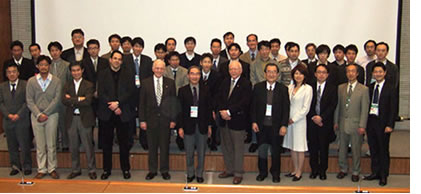A research area of Sakigake (PRESTO) program, "Evolution of Light Generation and Manipulation", held a debrief session of 10 Term-1 scientists, which finalized their projects. It was one of the symposiums in The 2009 Spring Meeting of the Japan Society of Applied Physics (JSAP) inviting 4 world's top level scientists including Dr. John L. Hall, Nobel laureate in physics.
The research results of the PRESTO research area were brought to attention of an international level, and also its technical prospects for the future were animatedly discussed. Research contents were highly recognized, and at the wrap-up session in which the PRESTO researchers participated as panel members in overall discussion, Dr. Hall and Dr. Corkum offered words of encouragement to young researchers and valuable comments and prospects for the future of optical science. Those comments, proposals and this experience would be precious assets for young PRESTO researchers.
The lecture contents comprise 4 main categories: (1) Optical Frequency Comb & Optical Atomic Clock, (2) Optical Synthesis, (3) Attosecond-Angstrom Science and (4) Coherent Optical Control.
Concerning the category (1), Dr. John Hall, the father of Laser Frequency Stabilization, gave a look over the research history and the application of the research for use in industry for the future. He presented that his pursuit of light with ultimate frequency stability led to redefining "1m" by using light as a yardstick, to determining "1 second" with 17-digit accuracy, and to "Optical Frequency Combs" in which lights with tens of thousands of frequency stand orderly, and it made the ripple effects to develop totally new medical diagnosis methods. From the PRESTO side, 2 presentations were made in concert with this category, such as "Generating circuit with atom-wave" by Dr. Kumakura.
Concerning the category (2), Dr. Kishan Dholakia from England introduced "Application of optical trapping to biophotonics" which handles biological material using light as if using tweezers. From the PRESTO side, Dr. Omatsu presented a new optical source which enables many ways of handling and processing of micro materials, and Dr. Katsuragawa presented a new technique to generate as many as 50 laser beams from a single laser beam and use them as a "Optical Synthesizer", like a synthesizer which generates chords from each sound of the keyboard.
Concerning the category (3), Dr. Paul Corkum who is called the "Father of attosecond science", introduced the latest research of "Attosecond-Angstrom Science". It is an ultramicroscopic world of both in terms of time and space, where the internal structure of molecules (oxygen, nitrogen and so on) can be seen and even electron movements around atom look motionless. From the PRESTO side, 2 presentations were made, including the introduction of a new computer simulation method, a theoretical study in the same field, to make possible an accurate prediction of physical phenomena at attosecond range, and the introduction of a theoretical prediction of the necessary condition for generating more high-intensity attosecond pulses, by Dr. Ishikawa.
For the category (4), Dr. Jure Demsar from Germany introduced that time-resolved measurement with ultrashort pulse light is effective to elucidate superconductive phenomena. From the PRESTO side, 4 presentations of new research projects associated with pursuing optical physics and its application prospects were made, including the introduction by Dr. Kubo of the world's first video transmission in which "light wave and electron wave", generated when metal surface is irradiated by shining light, cause interference each other moving at high speed. For each lecture, various opinions were exchanged actively involving those from public participants. The poster session by 14 Term-2 and 3 scientists was also greatly successful, and a heated argument was continued in front of the posters beyond the scheduled closing time.
Although it was the first time for the PRESTO program to hold a public debrief session at an academic society lecture in an international environment, a total of 320 participants and their air of excitement integrated the speakers and the hall, creating a kind of feeling just like "Call and Response" in Jazz.

For more information on the programs etc please view the following website (PDF).